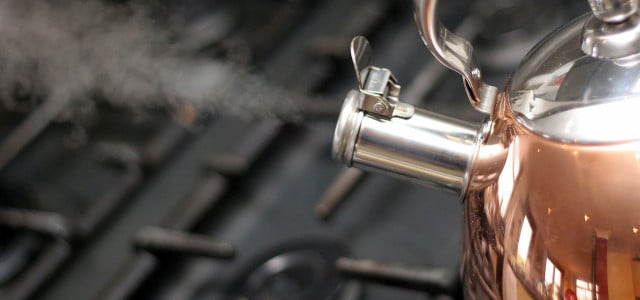Lime and calcium deposits look unsightly on your kettle and increase energy consumption. With our household remedies, you can effortlessly descale kettles and get them shining again.
Calcified Kettle – What’s Wrong with That?

Lime is a naturally prevalent compound in tap water. The concentration varies by region and water source. When you heat water in the kettle, lime begins to build up on the surfaces.
When the kettle becomes covered with a layer of limescale, it’s time to descale your kettle. Why? Because more energy is required to heat the water. This also means that it takes longer to boil the water. The lime deposits can also become a breeding ground for bacteria. And let’s face it: who likes to see lime flakes floating around in their tea?
Read on: Conserving Energy: 10 Ways to Save Electricity
How to Descale Kettles with Vinegar
Luckily, you can easily dissolve lime buildup with vinegar. It’s inexpensive and you probably already have it on hand. This means you won’t need to purchase any costly special products to descale your kettle.
Instructions:
- Fill your kettle with about 500 ml (2 cups) of water and add 30 ml (2 Tablespoons) of concentrated vinegar essence or 150 ml (5 oz) of white vinegar*.
- Allow the kettle to boil. Stand clear from the kettle, as the vinegar vapors can be quite pungent and irritate the eyes and mucous membranes when in direct contact. Open a window to allow the vapors to dissipate more quickly.
- Let the kettle soak for about half an hour so that the limescale has time to dissolve.
- Empty the kettle and boil new water in it to rinse away the vinegar.
*The main difference between household vinegar and concentrated vinegar essence is the acetic acid content. For household vinegar, this is about 5% by volume. For concentrated vinegar essence, it is usually more like 25%. If you don’t have the concentrated stuff at hand, just add a little more household vinegar to the kettle. For example, 30 ml of 25% acid vinegar is about 150 ml (5 oz) of 5% acid vinegar.
Descaling Your Kettle with Citric Acid
You can also descale your kettle with citric acid. However, you should never heat citric acid in the kettle! When heated, citric acid reacts with lime to form calcium citrate. This substance is similar to the lime deposits, but even more difficult to remove.
Instructions:
- Fill your kettle with about 500 ml (2 cups) of cold water
- Add 1 Tablespoon of powdered citric acid.
- Allow the solution to soak in the kettle for about 45 minutes.
- Rinse the kettle twice with cold water.
This article was translated from German into English. You can view the original here: Wasserkocher entkalken mit Hausmitteln – so geht’s
** Links to retailers marked with ** or underlined orange are partially partner links: If you buy here, you actively support Utopia.org, because we will receive a small part of the sales proceeds. More info.Do you like this post?







